By Công Thành
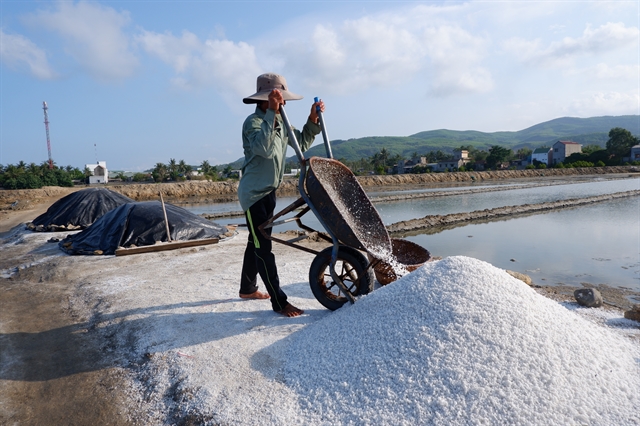
A NAME MADE: A farmer collects salt from fields in Phổ Thạnh Commune, along the coastline of Sa Huỳnh in Quảng Ngãi Province. Sa Huỳnh salt emerged as a specialty centuries ago. Photo courtesy of SAHU
Blanketing 110 hectares of one of the longest and most beautiful stretches of coastline in central Việt Nam, the Sa Huỳnh salt fields -- 60 kilometres south of Quảng Ngãi City in the province of the same name -- was as a source of salty food centuries ago.
Snaking along the north-south highway and railway line, the salt fields were exploited during French colonial times, with the salt ending up on tables in Europe.
They remain a source of livelihood for 1,200 farmers in Phổ Thạnh Commune -- the central area of the salt fields and of the famed Sa Huỳnh Culture.
Sa Huỳnh salt was mostly used in kitchens around Việt Nam and was a key element in fermenting fish sauce at fishing villages along its coast in centuries past.
Output stands at 8,000 tonnes per crop but farmers need more than the small sum that earns them as prices are low.
Little known is “flower salt” -- thin layers crystallised on the surface of salt fields -- which sells for ten times the price of regular salt and is a luxury served at fancy restaurants or snapped up by food connoisseurs.
Sa Huỳnh native Phạm Hồng Thắm, 27, was a trailblazer in reviving the old trade in the high-value salt.
“I’m no innovator -- I merely awoke the production our ancestors set up centuries ago,” Thắm said.
“I have encouraged local farmers to collect the best quality salt rather than lose it to mass production.”
A graduate in law at a HCM City university, Thắm eventually started up a brand for her homeland’s salt.
“I was shocked by the fact that 100kg of salt could not buy a bowl of phở (beef noodles), which was a bitter taste local farmers had swallowed for years,” she lamented.
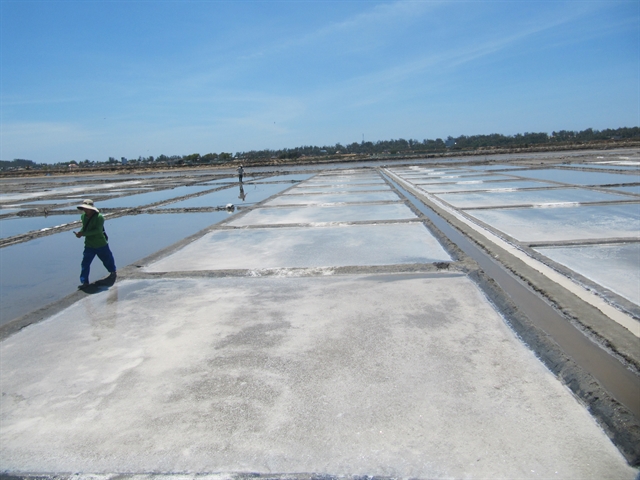
PROCESS UNDERWAY: Crystallised salt in the Sa Huỳnh fields. Four days is needed to turn seawater into salt. Photo courtesy of SAHU
“I then tried to find companies that would buy and sell SAHU (an abbreviation of Sa Huỳnh) salt,” she remembered.
“The best quality salt, including flower salt, coarse salt, naked salt (salt steamed in a clay pot), and bubble salt (salt crystallised from bubbles of salt), was sold online.”
Seventeen different salt products are now made by local farmers, she said, and they can double their income.
Trần Văn Dũng, 55, a farmer in Phổ Thạnh, said trade of the better salt has long been the local preference.
“Farmers could only ever sell salt at traders’ fixed prices, or else it would just pile up in our storage areas, which are limited,” Dũng explained. “But trade in the best salt was established at the local level.”
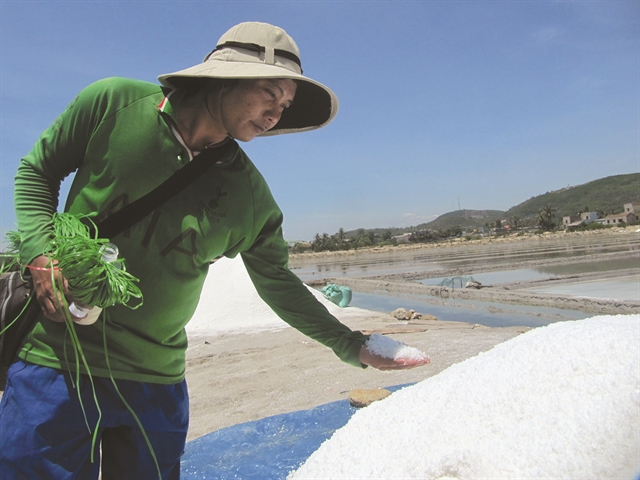
TEST FOR THE BEST: A supervisor checks the quality of salt from the Sa Huỳnh fields. The best quality comes naturally from pure seawater. VNS Photo Công Thành
He said 70 farmers had now joined the production chain of the SAHU brand.
The top-quality flower salt sells at double the price -- VNĐ175,000 (US$7.6) a kilo.
Phạm Ngọc Anh, a quality control supervisor at SAHU salt firm, said persuading farmers to adopt the best production processes took a long time.
Local farmers were reluctant to change production and looked at quantity more than quality.
“We encourage farmers to collect the best-quality salt because it earns the highest price, and to not exhaust the salt fields,” he said.
Naturally unique
Flower salt is indeed considered the purest and fetches the highest price.
“It really is a gift from the sea gods,” Thắm said. “We can only collect one kilo of this salt for every 100kg of regular salt we collect, with a total of 50 or 70 kilos taken out between March and August every year.”
“Farmers can earn more than VNĐ15 million ($650) a harvest from this top-quality salt, which is equal to 20 tonnes of regular salt.”
In the past, as Đỗ Chiến Nguyên, an old farmer, can attest, salt sold for just VNĐ500 (2 US cents) a kilo as oversupply was an issue.
“Farmers need a guarantee fund to help keep prices stable and lower any risk from market fluctuations,” he said.
Clean challenges
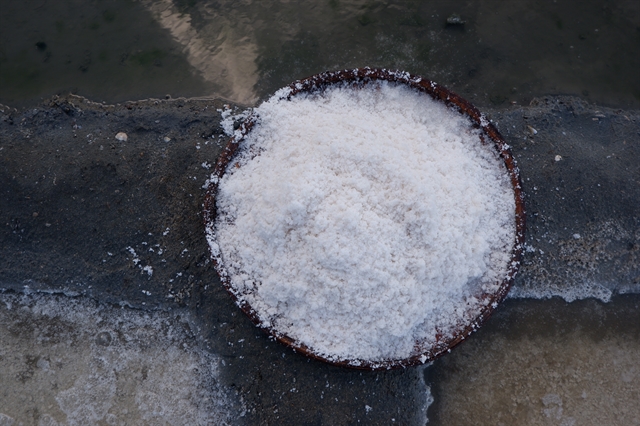
BRAND APPEAL: Salt in a bamboo basket. Sa Huỳnh salt has been one of the three most famous brands in Việt Nam for the past century. Photo courtesy of SAHU
Environmental pollution and booming urbanisation have been the greatest challenges facing salt farmers in Sa Huỳnh since the agricultural-based Đức Phổ District officially became a township.
Property speculation found its way to salt fields, with land bought and sold for quick profit, while new pollution problems for farming-intensive communities have resulted from the rapidly-developing township.
“We can’t control the quality of the seawater,” Thắm said in concern. “Pollution from industrial zones or factories can damage the quality of Sa Huỳnh salt.”
“A sustainable solution must be identified to strike a balance between urban development and salt preservation so our traditional trade can endure.”
Vice chairman of Phổ Thạnh Commune, Giã Tấn Tàu, said community-based tourism has been built into the value chain of the Lý Sơn - Sa Huỳnh Geopark, a popular local attraction, and various traditional crafts in the local area.
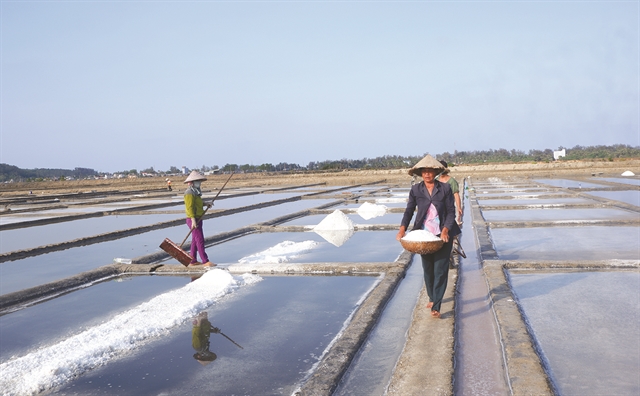
TAKEN AWAY: Women carry baskets of salt from the fields to storage areas. Photo courtesy of SAHU
The province built a salt processing factory and a seawater channel and dyke in 2006, he said, to ensure local salt production, but production proved ineffective.
Thắm hopes recognition of the Lý Sơn - Sa Huỳnh Geopark would, in turn, help promote the conservation of the Sa Huỳnh salt fields.
“There would no longer be any trade-off between culture and lifestyle, and farmers could earn a good living from the salt fields,” she believes. - VNS
OVietnam